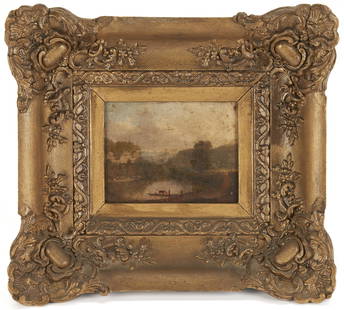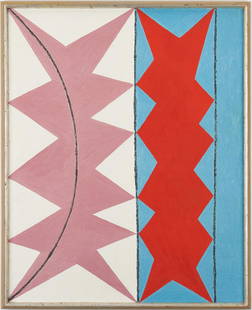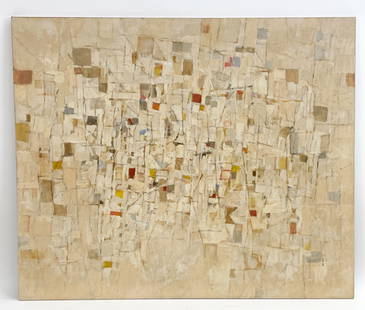
Admiral Rickover Makes Case for Nuclear Powered Surface
Similar Sale History
View More Items in PaintingsRelated Paintings
More Items in Paintings
View MoreRecommended Art
View More







Item Details
Description
HYMAN G. RICKOVER, Typed Letter Signed, to Edward J. Bloch, January 20, 1971, USS Enterprise, at sea, North Atlantic. 3 pp., 8" x 10.5" + envelope. On USS Enterprise letterhead. Very good.
In this outstanding letter, Vice Admiral Rickover makes a case for nuclear-powered surface ships for the U.S. Navy as an effective non-nuclear deterrent to Soviet communist aggression. The speed and versatility offered by nuclear-powered surface ships that did not have to slow for refueling or rely on a long fuel logistics supply line would allow the United States to project forces to any part of the globe to deter and prevent war, in Rickover’s view.
Excerpts:
“We are returning from the post-refueling sea trials of the USS ENTERPRISE (CVAN65), our first nuclear-powered aircraft carrier. The ship completed all tests, including full power operation, powered by her new design reactor cores which have enough fuel to last more than ten years.”
“During the last year the ENTERPRISE has been completely overhauled and reactor cores of an entirely new design have been installed in her eight reactor plants. These new cores contain energy equivalent to the amount of oil which could be carried on a train of tank cars stretching from Washington to Boston. This will provide her enough fuel to carry out all operations for the next 10-13 years, thus making her truly independent of fuel logistics support.”
“Nuclear power in surface warships gives them the ability to operate continuously at high speed which affords them protection not available to nonnuclear ships. This can mean the difference between winning and losing battles.”
“Next to providing the major deterrent to all-out nuclear war, I believe that the most important mission of our Navy is to insure that our first line naval striking forces can carry out their mission against the threats the Soviets are presently developing. A significant portion of our surface warships must be nuclear-powered or we may end up without a credible deterrent to communist encroachments which do not warrant escalation to a nuclear war.... As recent developments have shown, we can no longer rely on the threat of a nuclear war to stop communist aggression unless the issue is so vital to us that we are willing to risk destroying ourselves to resolve it.”
“It is widely understood that American naval superiority over the past 25 years has deterred nuclear war; it is not as widely understood that our naval superiority over this period has deterred lesser wars.”
“The nuclear carrier task force with its capability of unlimited operation at high speed is the most powerful, least vulnerable surface ship force in the history of naval warfare.”
“the cost of war itself far exceeds any cost needed to be prepared to prevent a war. The best warships we can build, hence the cheapest, are those which are never used in combat because they have served to prevent war.”
“the real value of having a Navy capable of countering the Soviet threat cannot be measured in dollars alone; our survival may depend on it.”
Hyman G. Rickover (1900-1986) was born in Russian Poland into a Polish Jewish family and migrated to New York City with his family in 1906. Two years later, they moved to Chicago. He graduated from the United States Naval Academy in 1922 and was commissioned an ensign. He served on a destroyer and battleship before earning a master’s degree in electrical engineering from Columbia University in 1930. He served on submarines from 1929 to 1933 and commanded a minesweeper for three months in 1937, but was soon sent to Washington for work in the Bureau of Engineering. During World War II, he did repair and inspection duties and gained a reputation as a man who got things done. Rickover became an early proponent of the idea of nuclear propulsion for naval vessels, both submarines and surface ships. He led a team that developed a reliable nuclear reactor that could power submarines, the first being the USS Nautilus, the world’s first nuclear-powered vessel, launched in 1954. Promoted to vice admiral in 1958, Rickover received the first of two Congressional Gold Medals. Over the next three decades, Rickover interviewed and approved or rejected every officer being considered for a nuclear ship, eventually numbering in the tens of thousands of interviews. The Secretary of the Navy eventually forced Rickover’s retirement in January 1982, just after his eighty-second birthday, after sixty-three years of service in the U.S. Navy under thirteen presidents.
This item comes with a Certificate from John Reznikoff, a premier authenticator for both major 3rd party authentication services, PSA and JSA (James Spence Authentications), as well as numerous auction houses.
WE PROVIDE IN-HOUSE SHIPPING WORLDWIDE!
Buyer's Premium
- 25%
Admiral Rickover Makes Case for Nuclear Powered Surface
Shipping & Pickup Options
Item located in Westport, CT, usPayment

Auction Curated By











































































